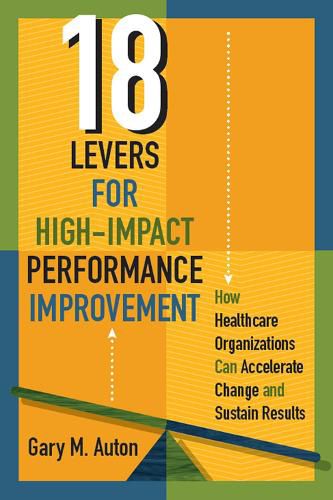Readings Newsletter
Become a Readings Member to make your shopping experience even easier.
Sign in or sign up for free!
You’re not far away from qualifying for FREE standard shipping within Australia
You’ve qualified for FREE standard shipping within Australia
The cart is loading…






The revolutionary shift toward value-based reimbursement is compelling healthcare organizations to produce demonstrated, measurable results for the services they provide-and to deliver those services in a manner that increases access to care and enhances patient engagement. Healthcare leaders, at the epicenter of this shift, are charged with guiding their organizations to improve quality, streamline costs, and preserve operating margins.
18 Levers for High-Impact Performance Improvement: How Healthcare Organizations Can Accelerate Change and Sustain Results is a practical guide for healthcare leaders tasked with improving the financial performance of their organizations. Bridging the gap between performance improvement theory and its real-world application, this book applies systems engineering principles and methods to such critical topics as strategic growth, portfolio management, revenue cycle, and clinical utilization improvement.
The author presents a framework of 18 performance improvement levers that can be deployed at various levels and degrees throughout an organization. Supported by multiple case studies, this framework is based on three premises: The changing business of healthcare requires performance improvement interventions that are faster, broader, and more strategic than those adopted in the past. Because most health systems are organized and structured in a similar way, they share similar, predictable operational challenges. Most performance improvement initiatives fall short of expectations not from a lack of skills, effort, structure, or tools but from an absence of prioritization and alignment.
This essential guide equips healthcare leaders with the stringent operating disciplines and effective improvement strategies they need to steer their organizations through an increasingly uncertain and complex environment.
$9.00 standard shipping within Australia
FREE standard shipping within Australia for orders over $100.00
Express & International shipping calculated at checkout
The revolutionary shift toward value-based reimbursement is compelling healthcare organizations to produce demonstrated, measurable results for the services they provide-and to deliver those services in a manner that increases access to care and enhances patient engagement. Healthcare leaders, at the epicenter of this shift, are charged with guiding their organizations to improve quality, streamline costs, and preserve operating margins.
18 Levers for High-Impact Performance Improvement: How Healthcare Organizations Can Accelerate Change and Sustain Results is a practical guide for healthcare leaders tasked with improving the financial performance of their organizations. Bridging the gap between performance improvement theory and its real-world application, this book applies systems engineering principles and methods to such critical topics as strategic growth, portfolio management, revenue cycle, and clinical utilization improvement.
The author presents a framework of 18 performance improvement levers that can be deployed at various levels and degrees throughout an organization. Supported by multiple case studies, this framework is based on three premises: The changing business of healthcare requires performance improvement interventions that are faster, broader, and more strategic than those adopted in the past. Because most health systems are organized and structured in a similar way, they share similar, predictable operational challenges. Most performance improvement initiatives fall short of expectations not from a lack of skills, effort, structure, or tools but from an absence of prioritization and alignment.
This essential guide equips healthcare leaders with the stringent operating disciplines and effective improvement strategies they need to steer their organizations through an increasingly uncertain and complex environment.